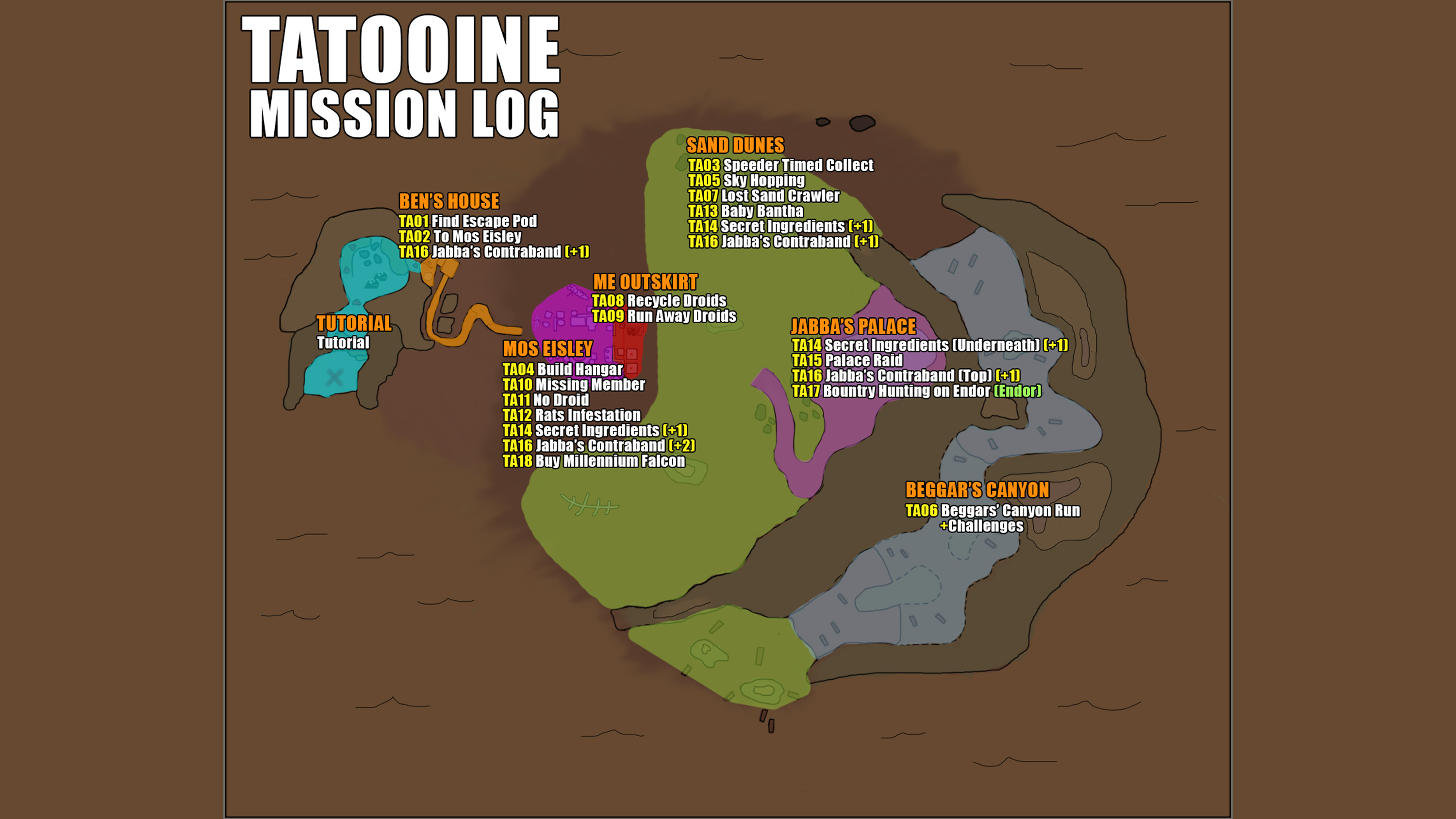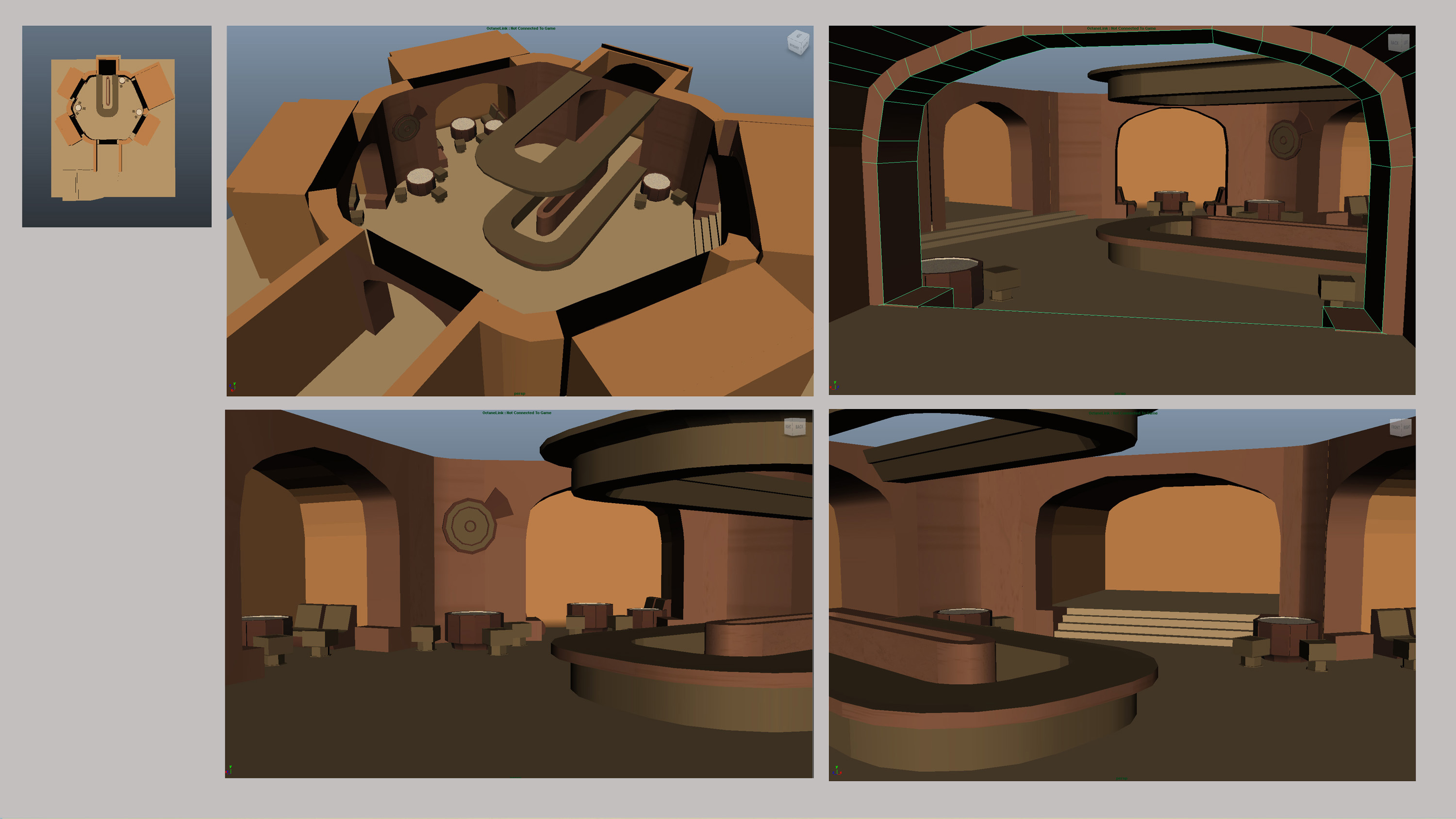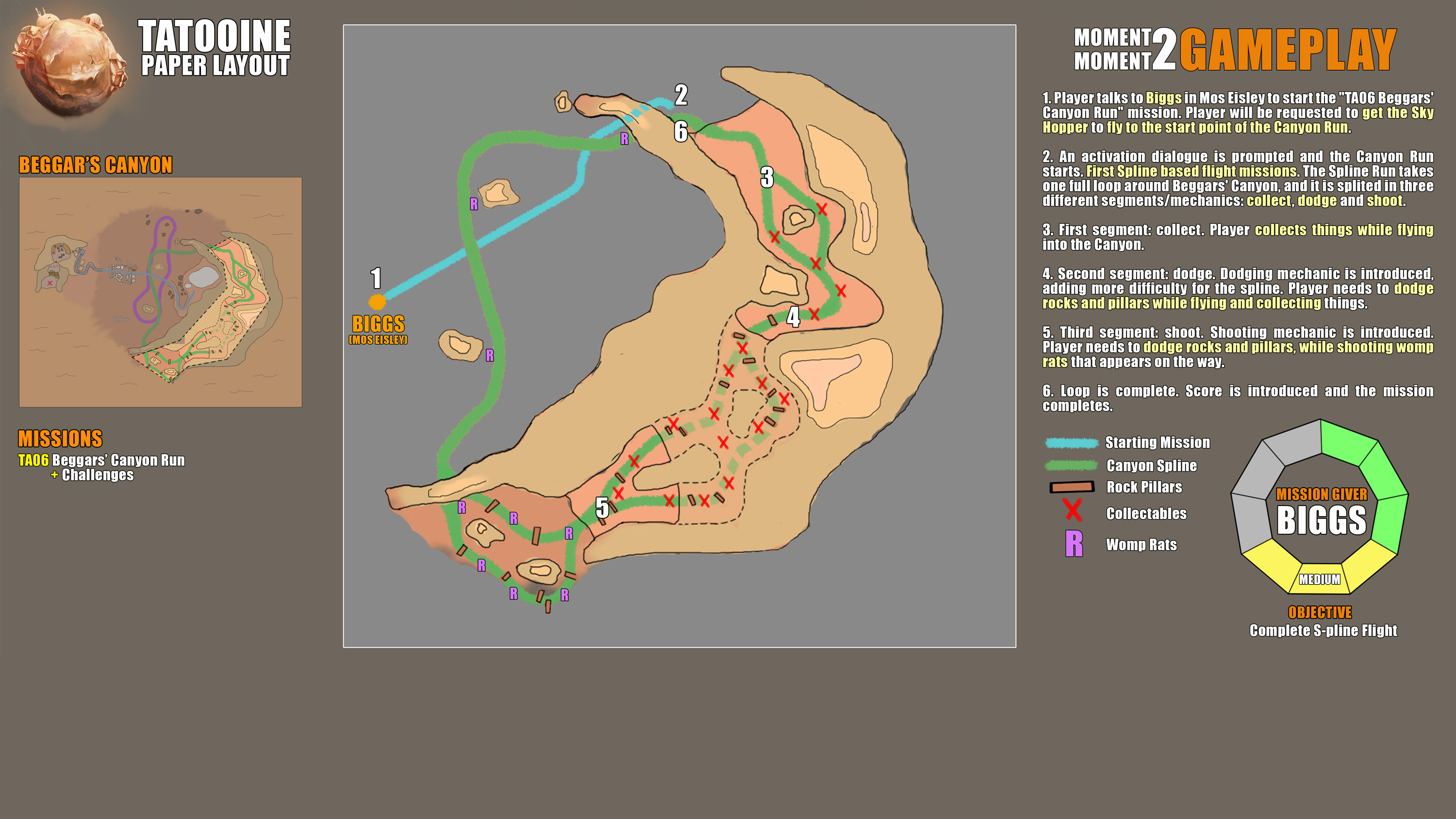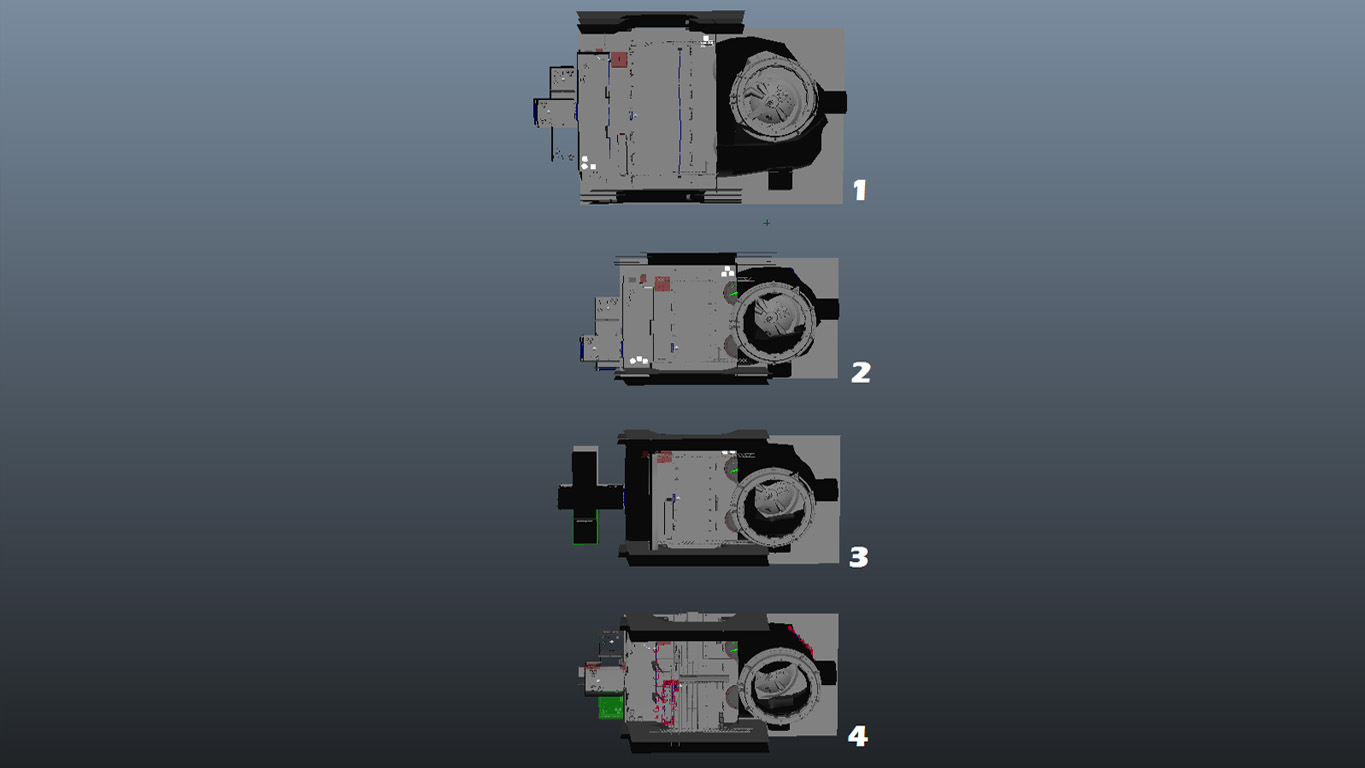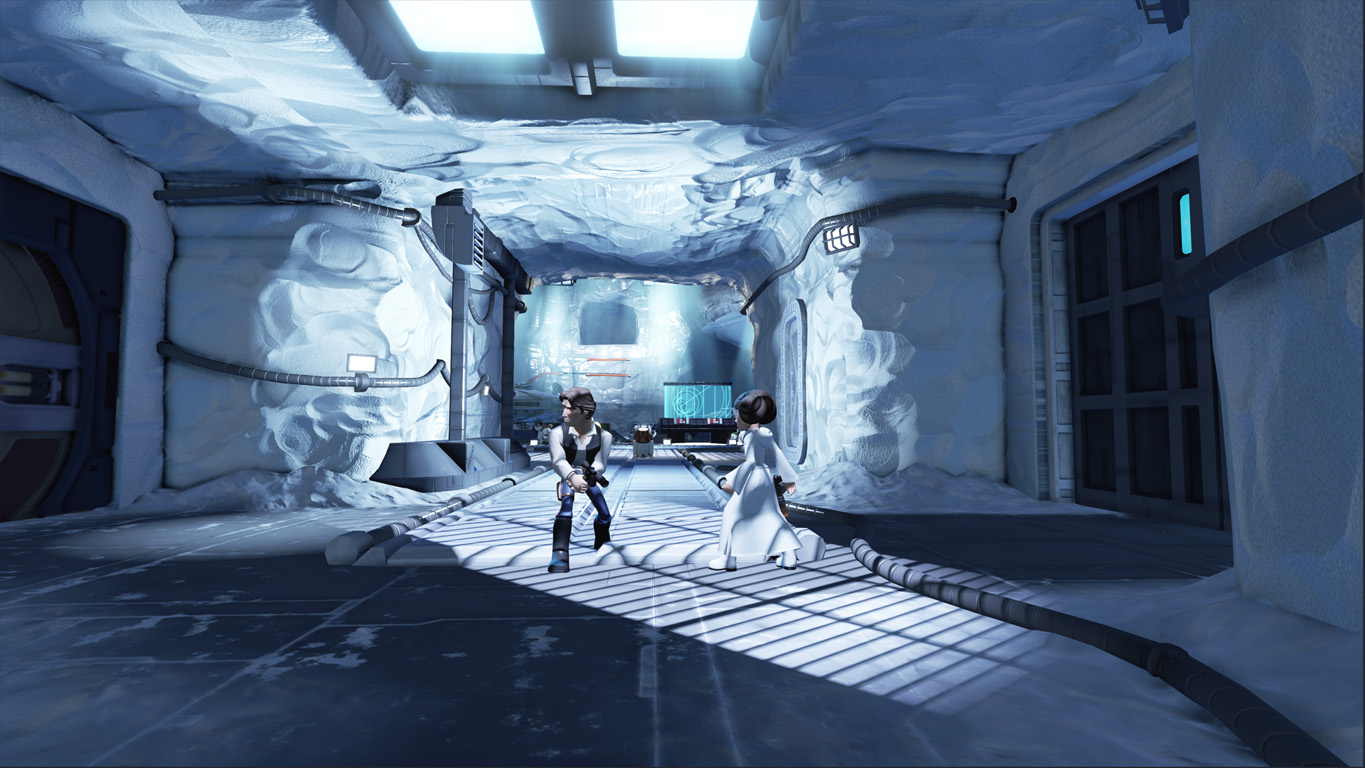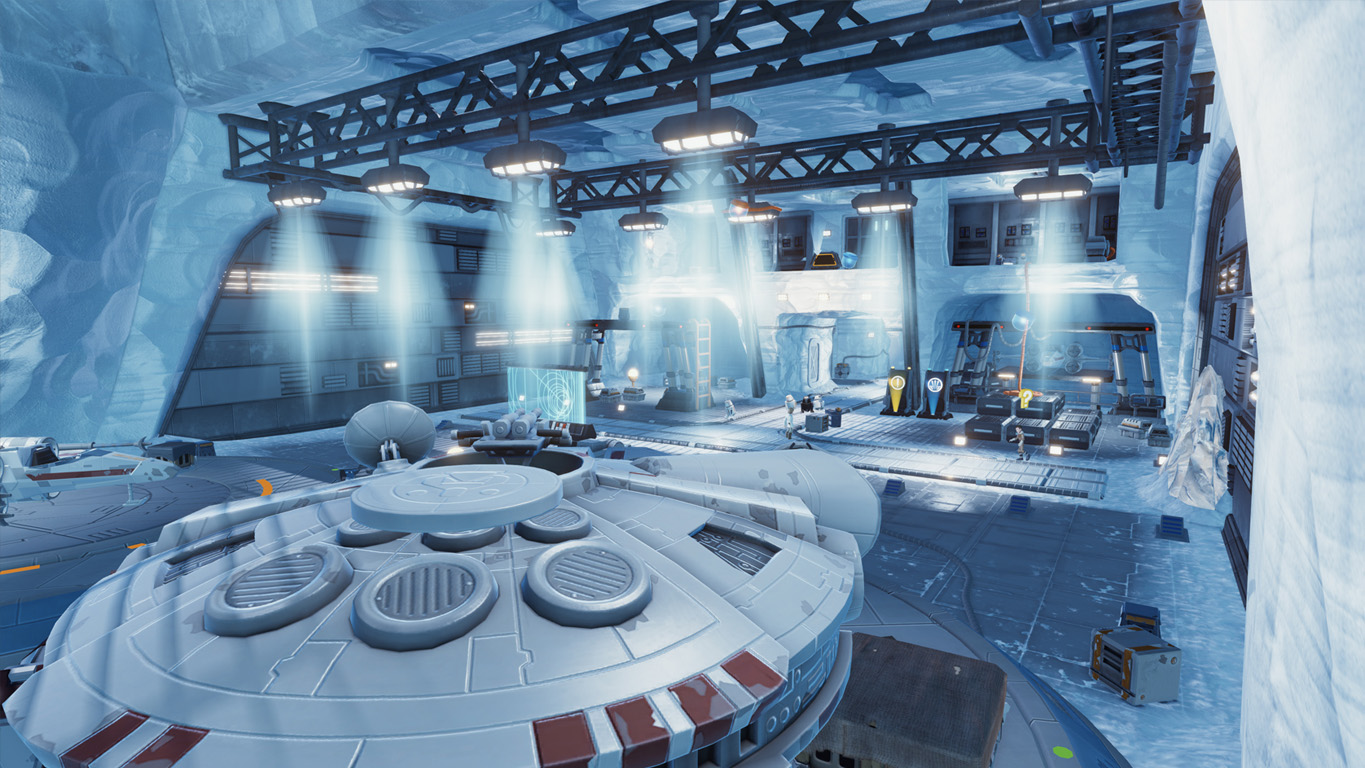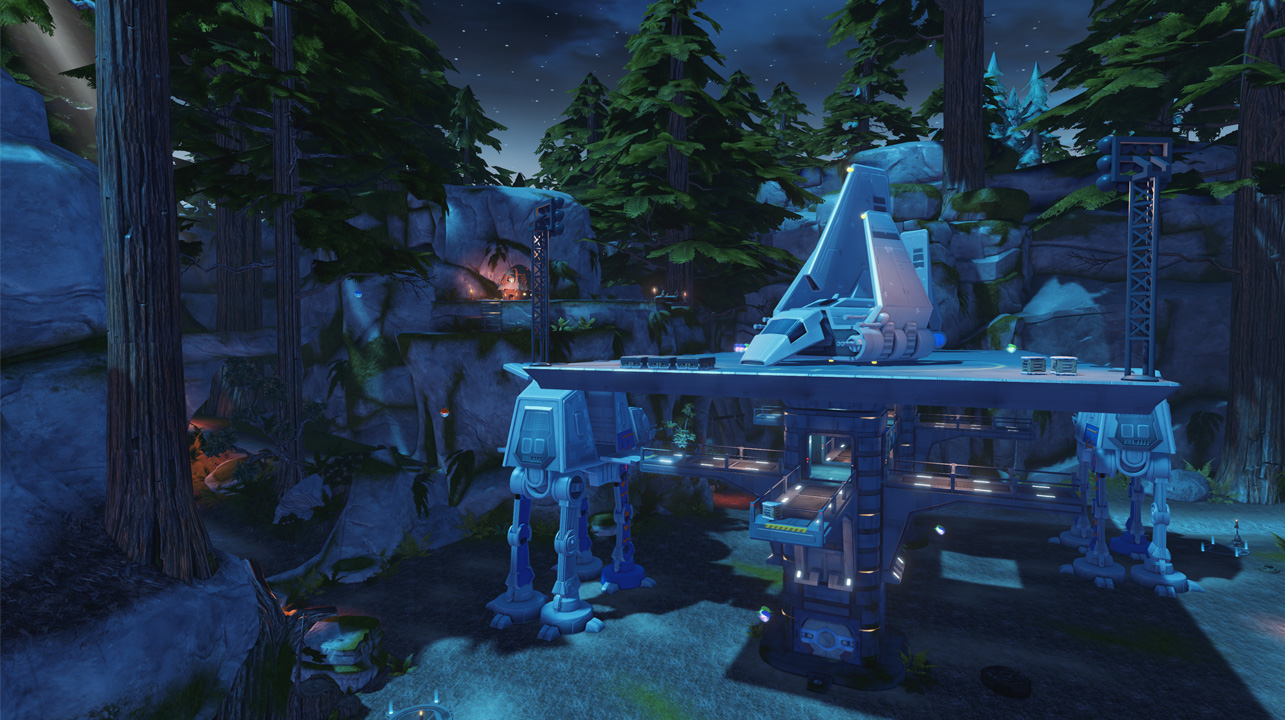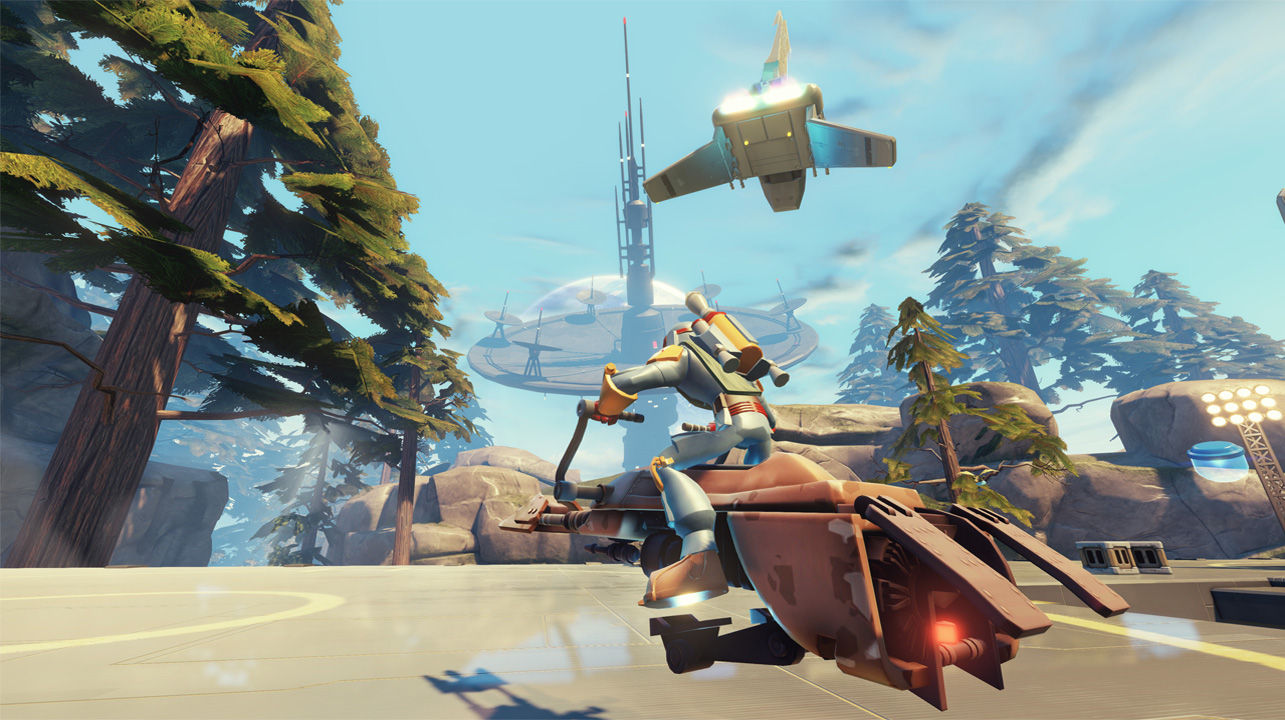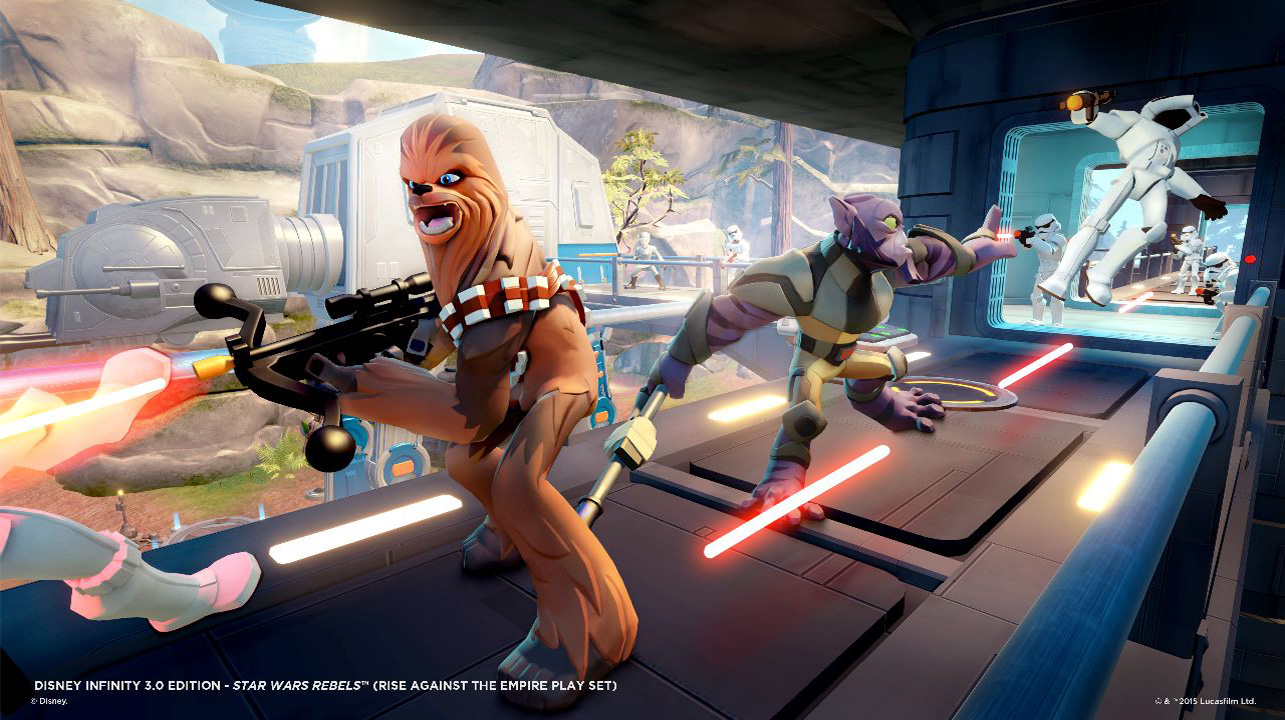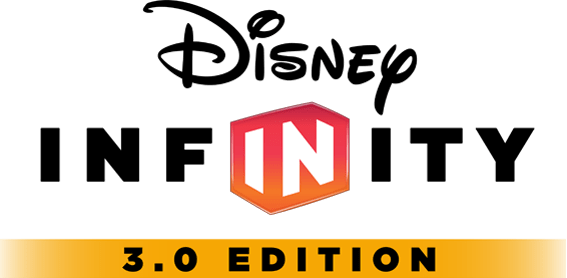
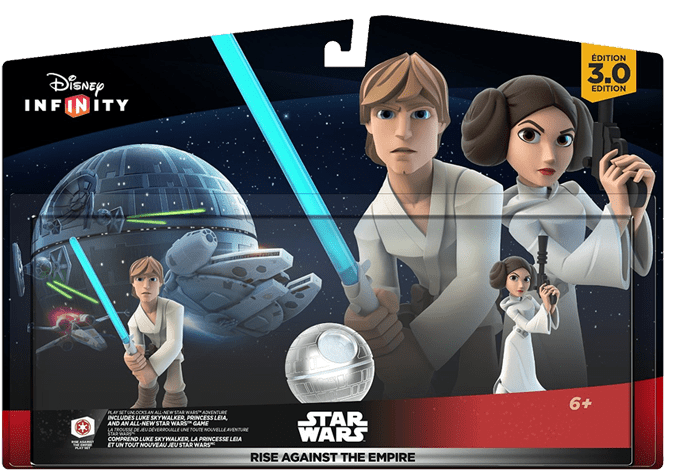
ROLE: GAME & LEVEL DESIGNER
ROLE: GAME & LEVEL DESIGNER
Disney Infinity: Star Wars Rise Against the Empire Playset is an action-adventure sandbox toys-to-life video game based on Episodes IV-VI of the Original Star Wars saga.
I was primarily responsible for Designing the planet of Tatooine, while also working in some aspects of Hoth and Endor. Level Design tasks included concepting, defining mechanics, paper layout, greyboxing, testing and scripting.
I also had full ownership of all of the Open World Missions across the whole playset, and on polishing all Main-Line Fetch, Collect and Vehicle Based Missions.
CLIENT
LucasArts
Disney Interactive
DATE
October '14 - August '15
TOOLS
Maya w/ Octane Engine, Photoshop, Hansoft, Visio
GAME OVERVIEW
The Rise Against the Empire Play Set is one of the three Star Wars play sets in Disney INFINITY: 3.0 Edition.
The play set is an action-adventure sandbox game that leads the player through the galaxy to stop Darth Vader and the Galactic Empire. It takes the player to three different planets (Tatooine, Hoth, and the Forest Moon of Endor), as well as The Death Star, Jabba’s Palace, and other places.
During the initial stages of the project my focus was on building the Tatooine and Hoth levels, focusing on faithfully recreating the magic of the movies within the Disney Infinity setting. I also handled Game Design of the open world missions throughout these levels, as well as assisting the team on some Level and Game Design for Endor. Throughout the project our design focus was to emphasise the toys-to-life experience within the game, making every aspect feel fun and interactive, while also remaining as true as possible to the source material.

"Studio Gobo has crafted one of the best Play Sets ever made for Disney Infinity."
- MMGN
"Studio Gobo has crafted one of the best Play Sets ever made for Disney Infinity."
- MMGN
RESPONSIBILITIES
Level Design
Tatooine, Hoth & Endor
Responsible for tasks such as concepting, paper layout, greyboxing and scripting. I owned the design for Tatooine as a whole, while also working on Hoth & Endor.
Game Design
Missions & Mechanics
I had full ownership on all of the Open World Missions across the whole playset, and on polishing all Main-Line Fetch, Collect and Vehicle based Missions.
Collectibles
Mapping Conditions
Responsible for mapping and assigning all sort of Collectibles and Unlockables. I’ve mapped all Crossover Coins, Holocrons, Mynocks, Capsules, Hitching Posts and Checkpoints of the game.
Character's Interactions
Secret Doors & Terminals
Responsible for deciding specific characters interactions with the level, while accessing Tech Terminals or Lightsaber Doors. I’ve mapped those and designed their intentions in the game.
TATOOINE - DESIGNING A SANDBOX EXPERIENCE FOR KIDS
One of my biggest responsibilities during production was owning the design of Tatooine. As this planet was the opening hours of our game, this area needed to set the scene for the playset, establish our overarching design goal of making everything feel toy-like, and also introduce many of the game’s core mechanics. If Tatooine didn’t kick off the game in the best way possible, players may not stick around for the rest.
Beginning a theme that would go throughout the game, we needed to be faithful to the source material – this meant including landmarks from the movie and following established story beats. Representing such a well-known setting created certain constraints which we needed to consider in our design, but also allowed me to inject a lot of fun into the environment and overall gameplay experience.
Based on this, Tatooine posed some of the biggest challenges as it should be an immense, open dessert world while still being designed with old gen consoles in mind. This meant designing levels to give the impression of a massive open environment that could still perform well on these older consoles.
We also needed to make sure that our main values on Disney Infinity would be reflected here: EVERYTHING IS A TOY, this is a kids game foremost and that our playground was an exciting Sandbox with infinite possibilities.
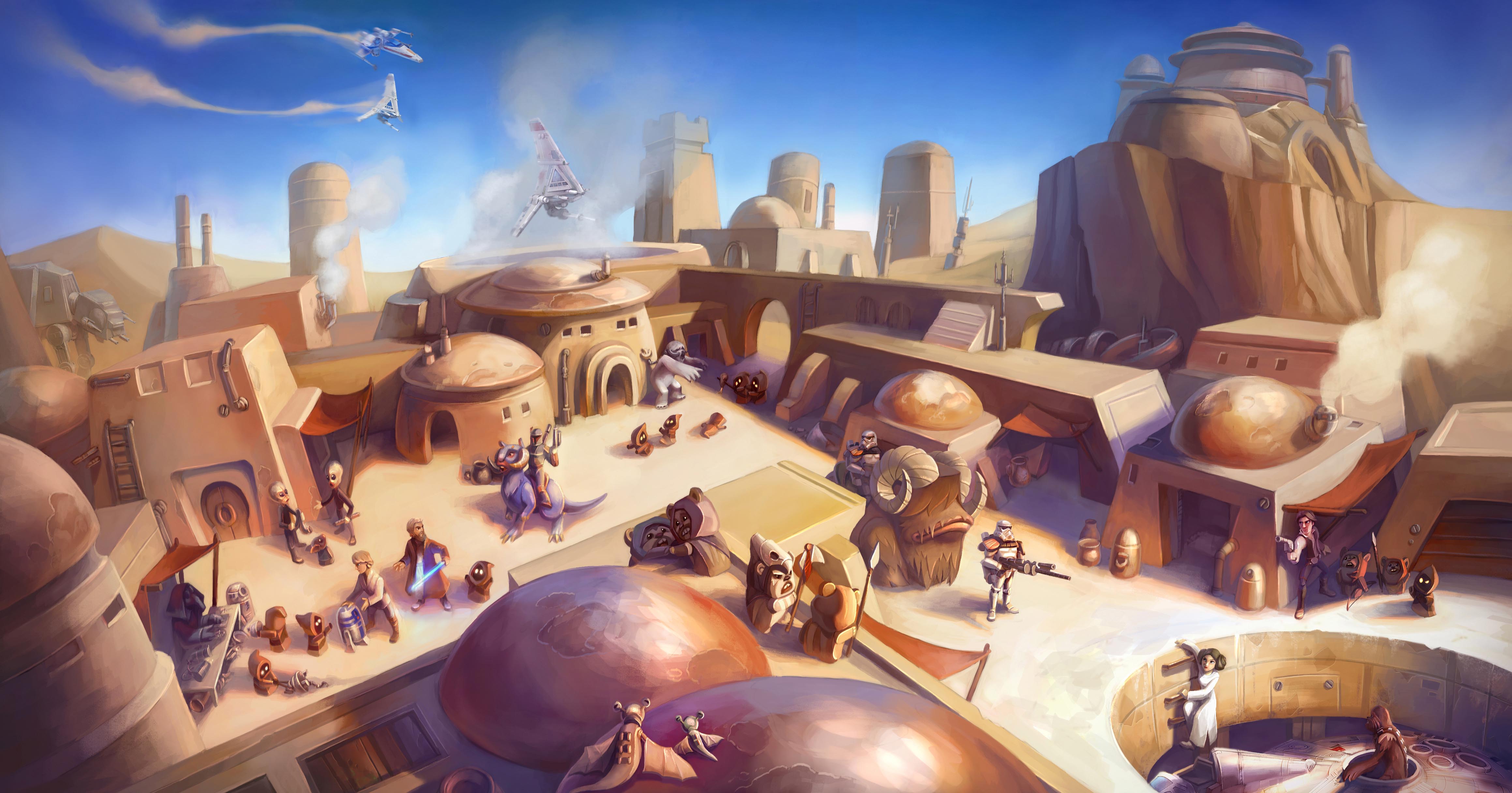
LEVEL DESIGN PROCESS
Throughout the different levels of the project, I followed a similar process for designing levels. Given the importance of staying true to Star Wars, I would kick this off by reviewing the source material and identifying landmarks and interactions that would need to be included, and using these to deliver as fun of an experience as possible. This helped me develop paper layouts of these areas.
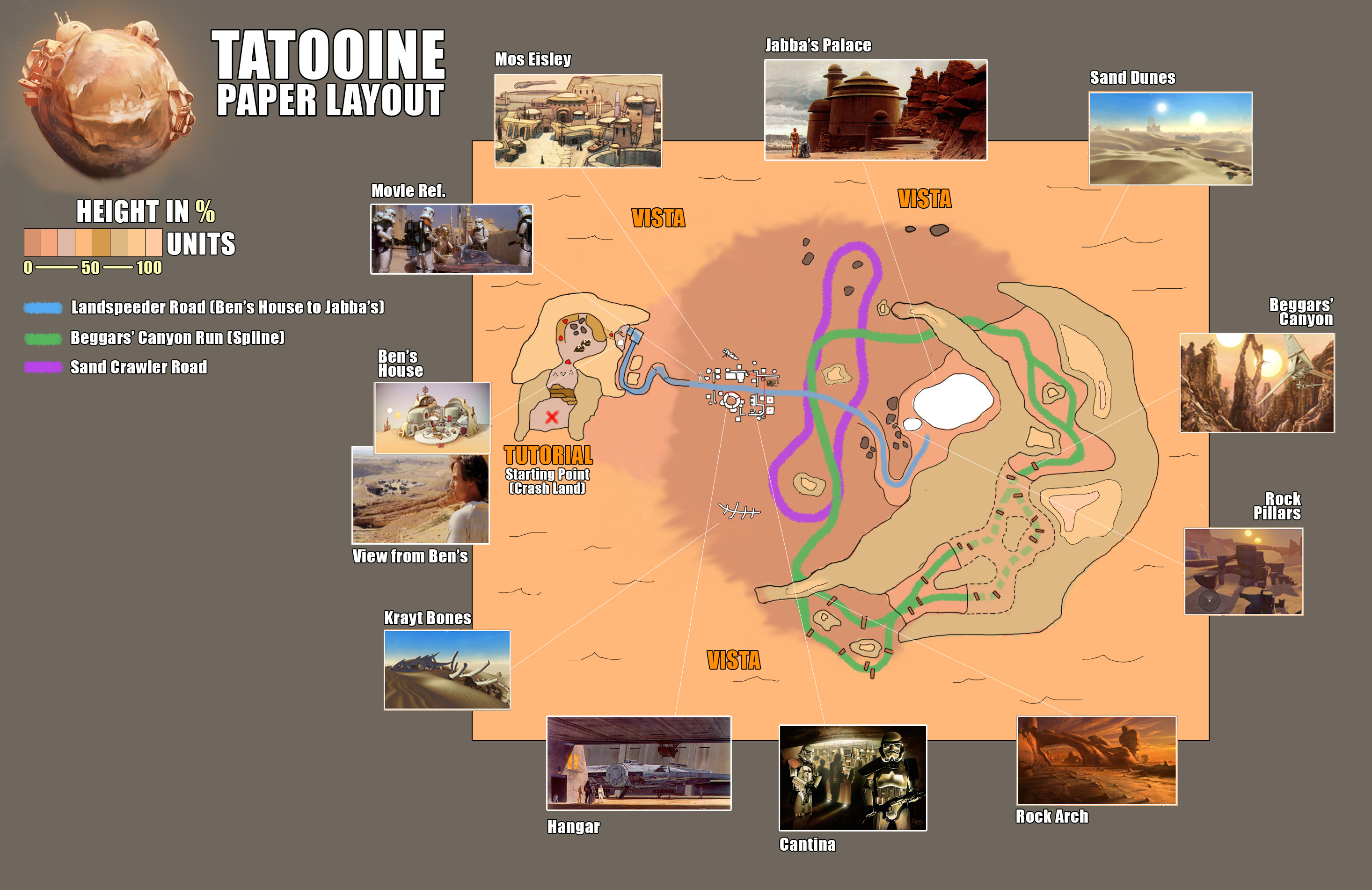
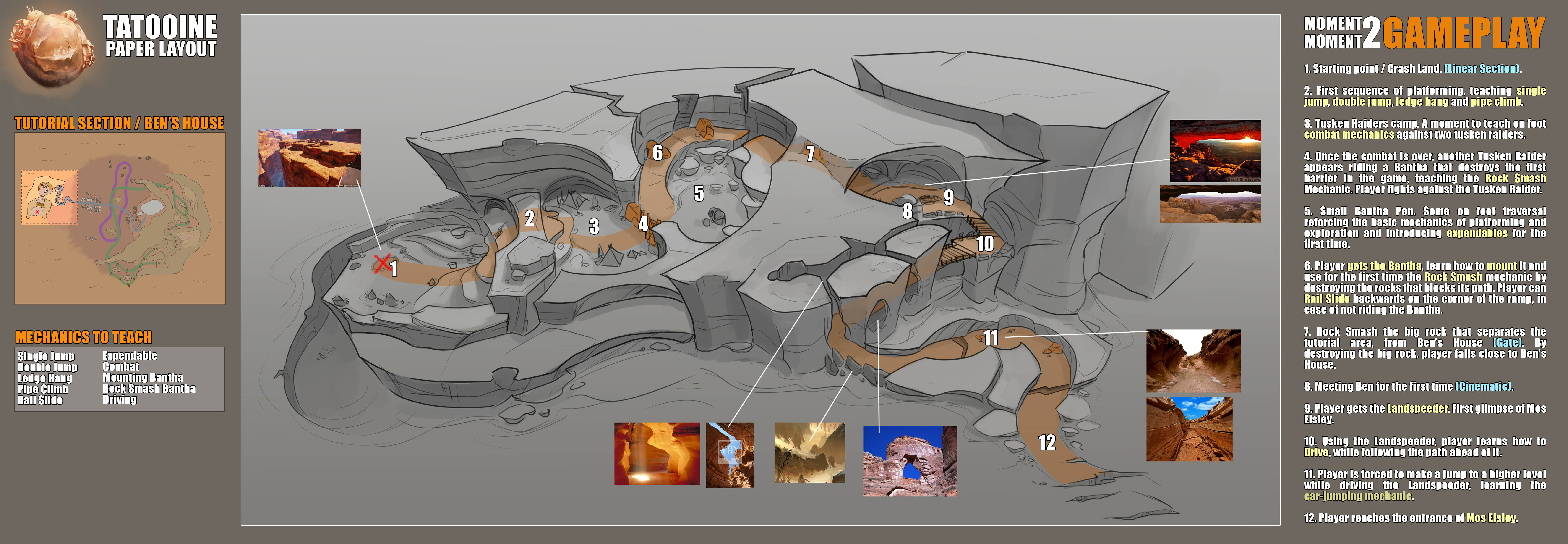
From early on in the project, I was constantly in touch with the concept art team to turn these diagrams into more realised parts of the Star Wars Universe. Tying in with our goal of making everything feel toy-like and interactive, it was really important that the buildings could offer different types of player interaction, supporting traversal and creating gameplay opportunities for new types of missions. I drew on top of concept art in order to begin exploring these ideas in more depth before moving onto greyboxing in Maya.
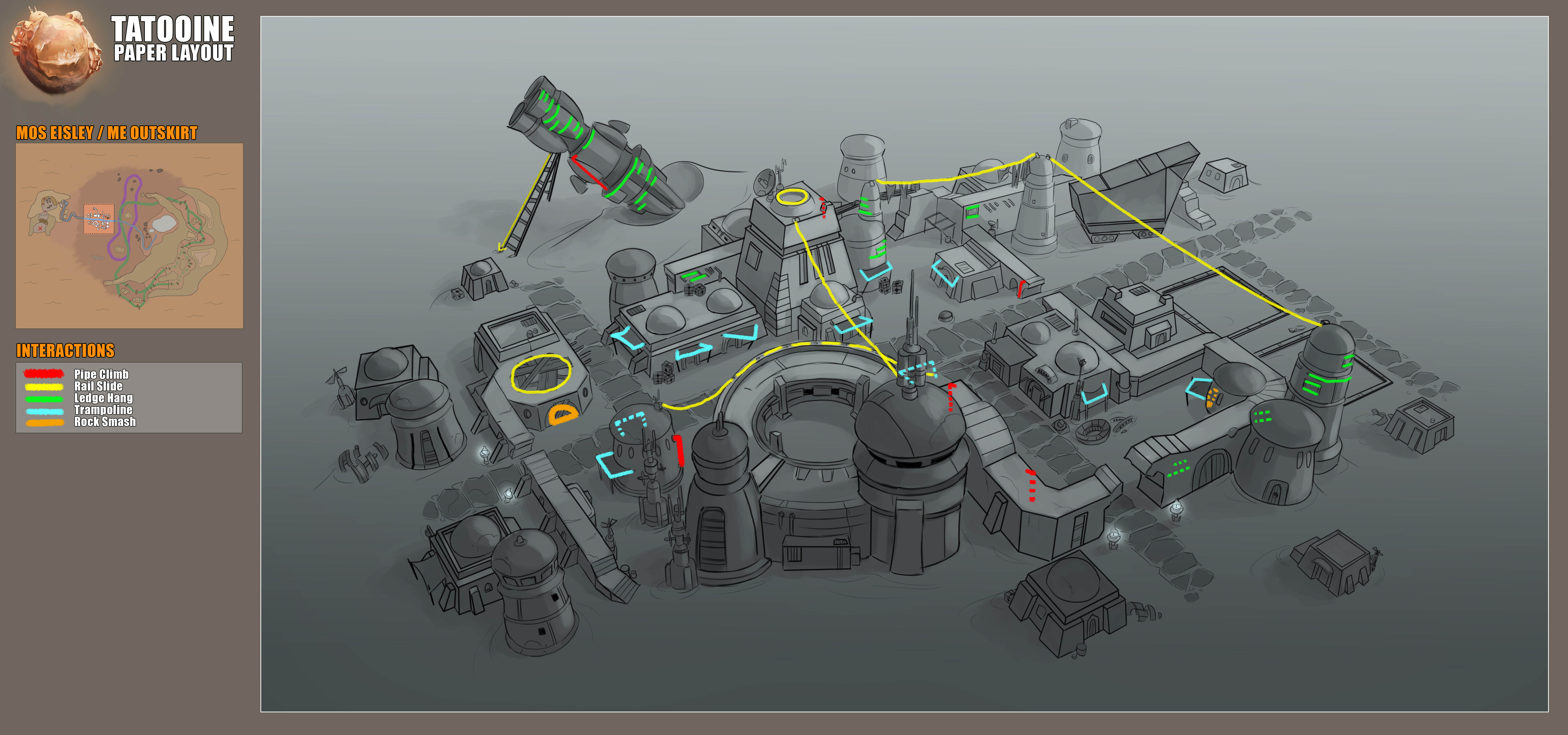
With an initial idea in mind, I would start rapidly producing prototypes in order to test ideas and get proposed interactions in front of players as soon as possible. This highly iterative process ensured that I was able to quickly zero in on what worked and what didn’t, and use this to inform my design throughout all levels across the whole project. With this results, I could start focusing on the Greyboxing process.
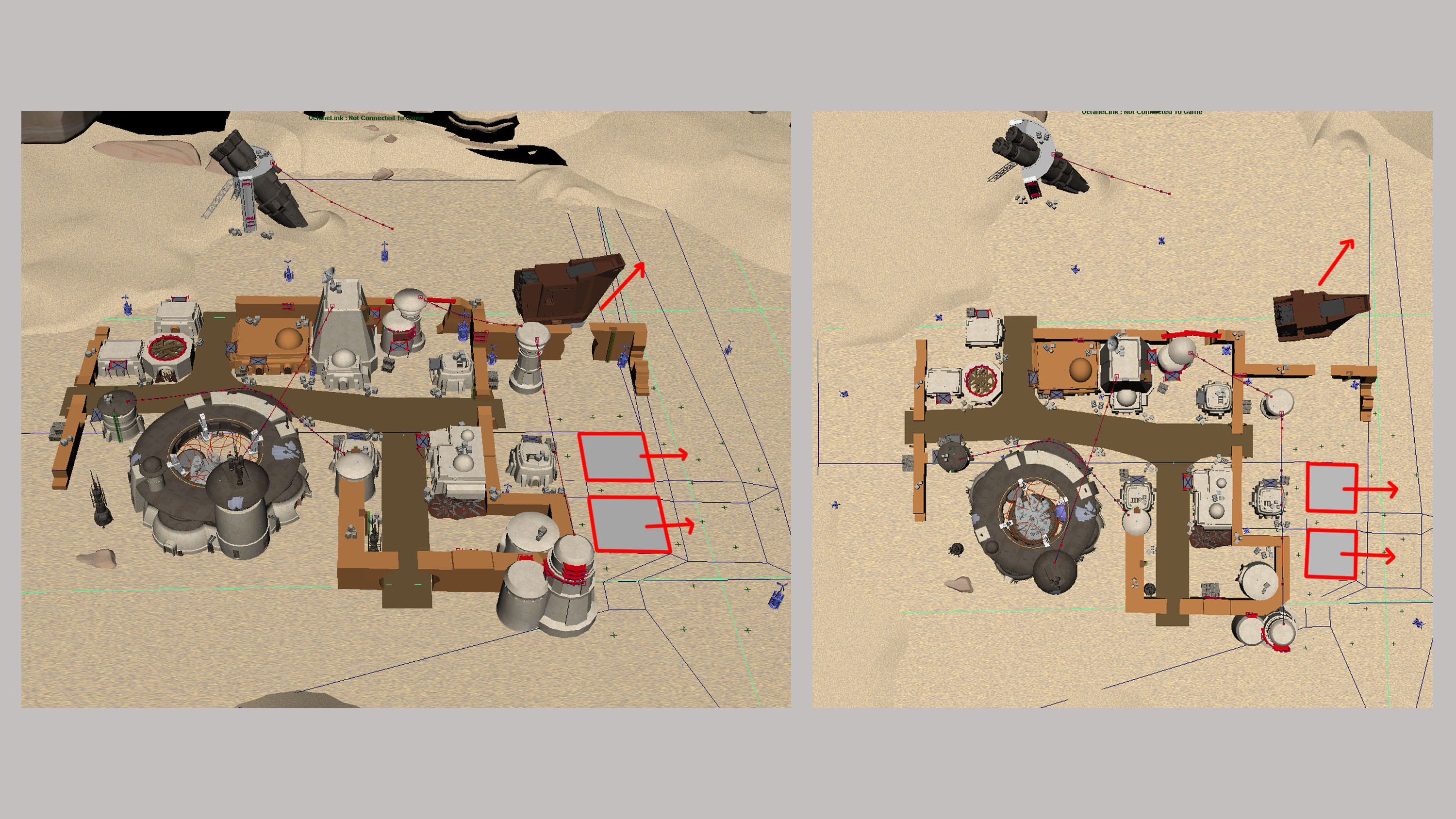
MOS EISLEY - THE VERTICAL PLAYGROUND
Mos Eisley is a defining moment in the Star Wars narrative, and features some of the most memorable settings and characters of the franchise. Given its reputation as a “wretched hive of scum and villainy” we needed the whole area to feel alive with energy, from both the characters in the level, to the interactions with buildings surrounding it. With this cherished feeling in mind, when prioritising what should be kept in Tatooine as a whole, we knew Mos Eisley should get special focus.
My intention for Mos Eisley was to prioritise Infinity features I knew tested well with players, in particular vertical traversal, high rooftops, rail slides, pipe climbs and ledge hangs. By introducing these elements to the static buildings, my intent was to create an environment that the player could really immerse themselves into.
To support extra sandbox gameplay interactions, I interspersed the environment with moment-to-moment gameplay using various expendable items. This encouraged players to really engage with the traversal elements I had introduced, while also using it as a tool to guide players to the right direction. This proved to work really well during playtests.
To add extra gameplay opportunities toward the end of the development of Mos Eisley, we wanted to get players using some of the really cool vehicle features such as the Skyhopper’s weapon and the Sandcrawler’s turret. To do this, I added Empire Targets to some of the tall buildings that needed to be shot.
With all of this gameplay going on in the level, I needed to be constantly aware of not putting too much strain on the game’s performance. Striking a balance between these competing priorities was an interesting challenge, more so for Mos Eisley than any other part of the game.
The main solutions I came up with was having specific spaces contained behind walls and inside buildings, and avoiding having too many actors loaded on screen at a given time. Making sure the level design was carefully optimised helped deliver the feeling we wanted for Mos Eisley without causing any technical problems.

OTHER POINTS OF INTEREST
It was important to the experience of the game that we included iconic landmarks and points of interest to Mos Eisley. That being said, we didn’t want to add a new place just for the sake of adding – everything that was added to the final game had to support a gameplay reason that could be fun enough to be there.
The Cantina is an example of something we absolutely couldn’t leave out. We wanted the place to be as impressive and cool as in the movie, and it went through five different iterations until we were happy with the final design that supported fun gameplay and was clear for players when inside.

To encourage players to really explore and enjoy the Cantina, I purposefully added two very important mission givers to this area. In order to make sure these weren’t missed, I toyed with the Cantina design to create spaces in the roof that would allow the Infinity Mission Beacons to be visible to the player outside of the building from any angle.
While the initial focus of Mos Eisley had been around exploration and traversal, we also wanted to reinforce combat missions which are a core part of the Infinity experience. As such, later in the development cycle, we added two unique and exciting opportunities for this using the Sail Barge and the Tusken Raider Camp.
Using PvP Combat tech provided by Avalanche, I created an arena using the Sail Barge floating over the Sarlacc Pit. This produced one of the most enjoyable experiences for players who could spend hours along taking turns throwing each other into the pit.
Finally, to encourage the use of the Bantha mount in the game, I added unique gates throughout Mos Eisley that needed to be smashed in order to gain access to secret areas and collectibles, adding extra hours of exploration and fun.
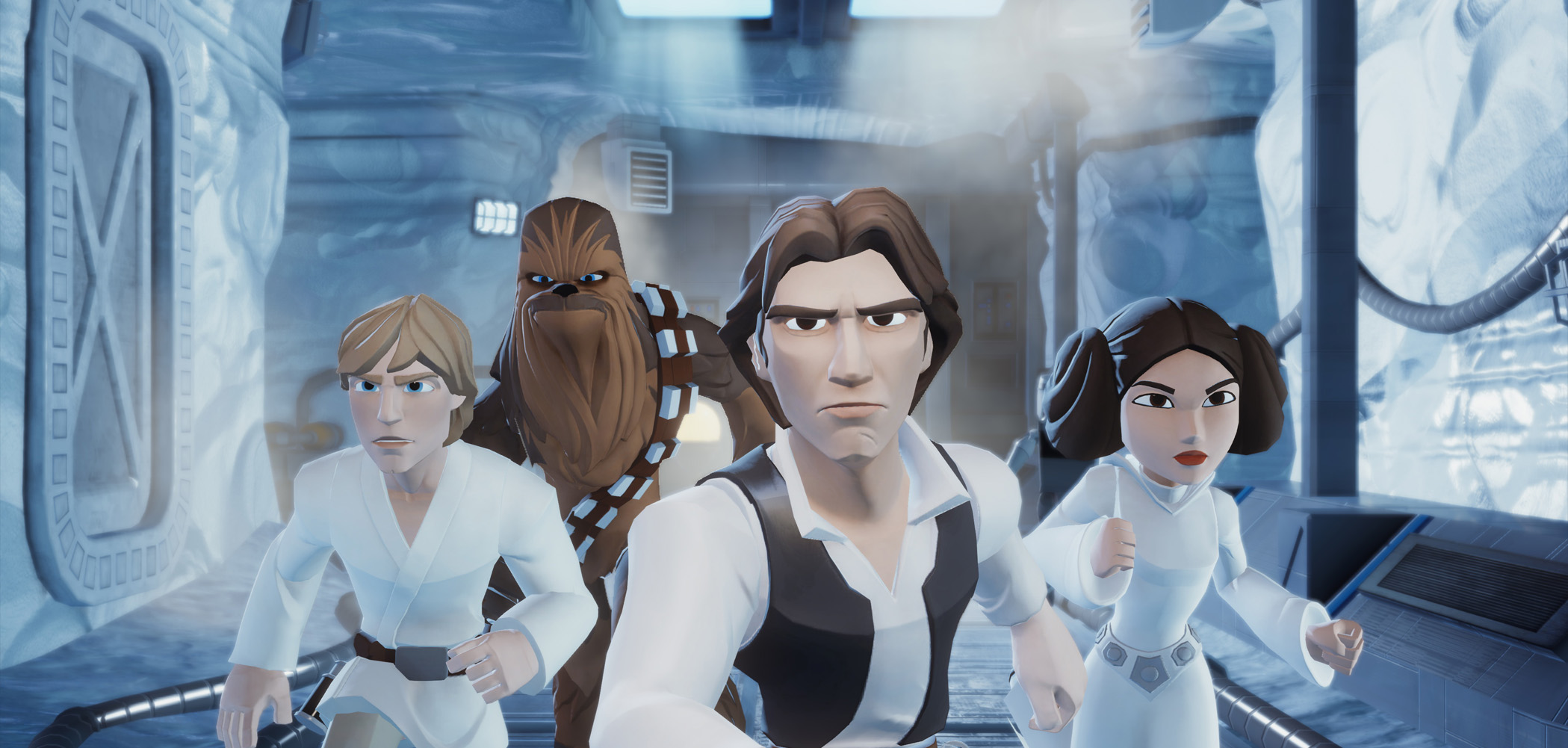
HOTH - DESIGNING THE ICE PLANET
Base building and customisation were always a major part of the Infinity experience, and were received positively during internal playtests and from post-release reviews. Because of this, we wanted to make this one of the selling points for our playset in order to continue to support the toy-like feeling we were aiming for.
With this in mind, Hoth was actually the first area that was designed during production, and a lot resources were focused here in order to experiment and iterate on the design.
Two big features would be in place here: our cool and customizable Hoth Base Buildings and the Remote Controlled AT-AT’s. And, with no surprise, both features were a huge success and brought back the magic of the Infinity franchise that got lost in 2.0 and Marvel Play Sets.
I was additionally responsible for scripting open world missions, and polishing existing missions. In particular for Hoth, missions should give a sense of urgency and reflect this big part in the story with the empire attacking, the driving and saving rebels from the base etc. This was always something I kept in the forefront of my level design in order to produce a cohesive experience.
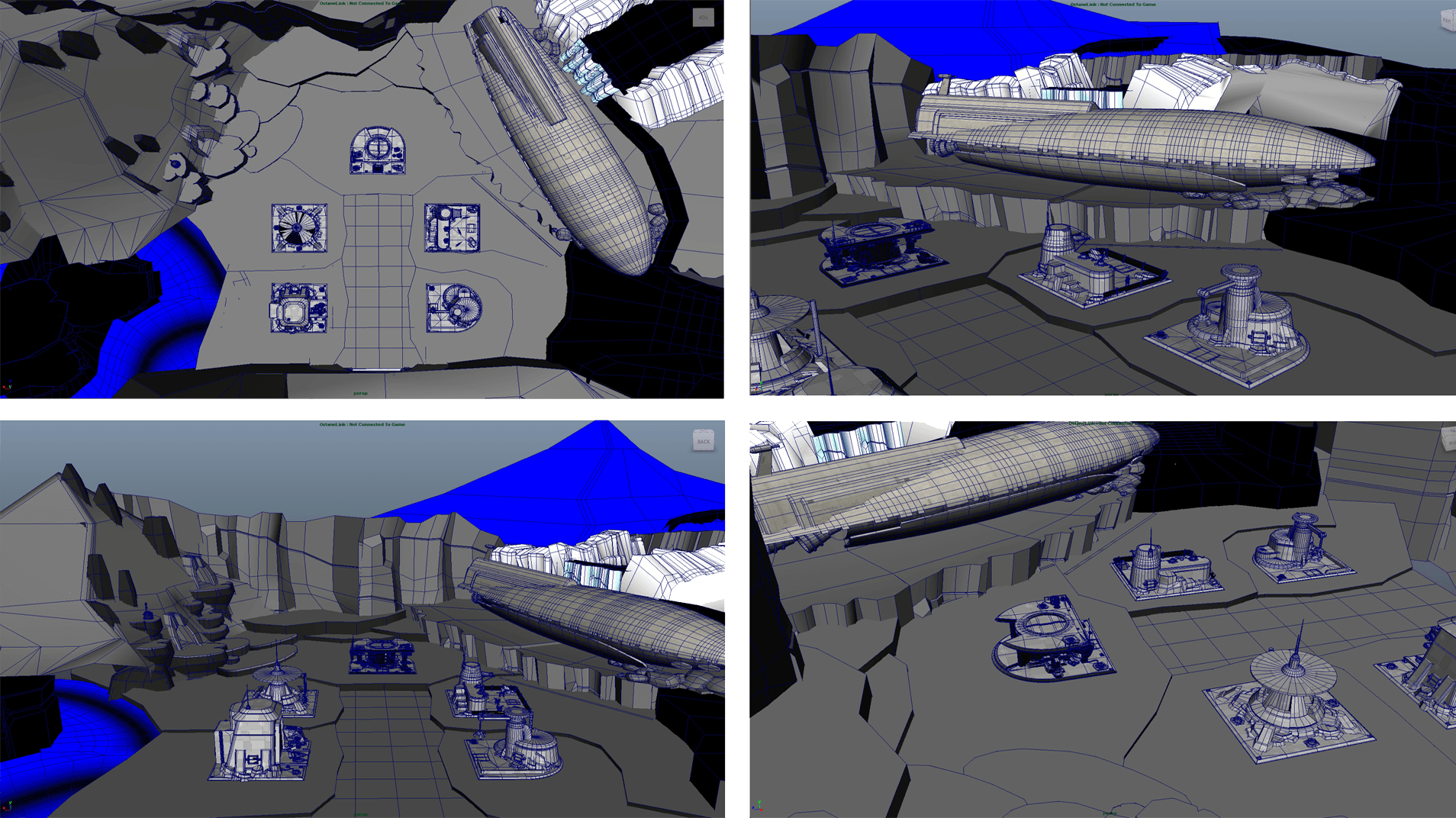
IT'S ALL ABOUT THE BASE!
Overall, the Hoth Base was the part of game that had the most number of iterations during development, and ended up being one of the last areas to be completed.
Initially I used paper layouts to conceptualise my vision for the base, providing versions that favoured a completely open layout for both the Base and Hoth Planet, to a more condensed base “hidden” behind the gates. For both the game’s performance and to be closer to the movie, we’ve decided to go for the latter option as it made sense that the Rebels would be protected behind gates and that they would build their protection inside walls and far away from the AT-AT’s.
Still, it took months to have the whole team's agreement, and many features ended up being stripped back for the final game. In order to get everyone aligned, we went back to our original design vision and defined exactly what purpose we hoped to achieve with the base. Ultimately we wanted to have a space in which the player could place their buildings, participate in activities / missions that each building would offer, and also to allow player to traverse from building to building if they like.
The final layout was a conclusion of work from both Tom Geddes and Me.
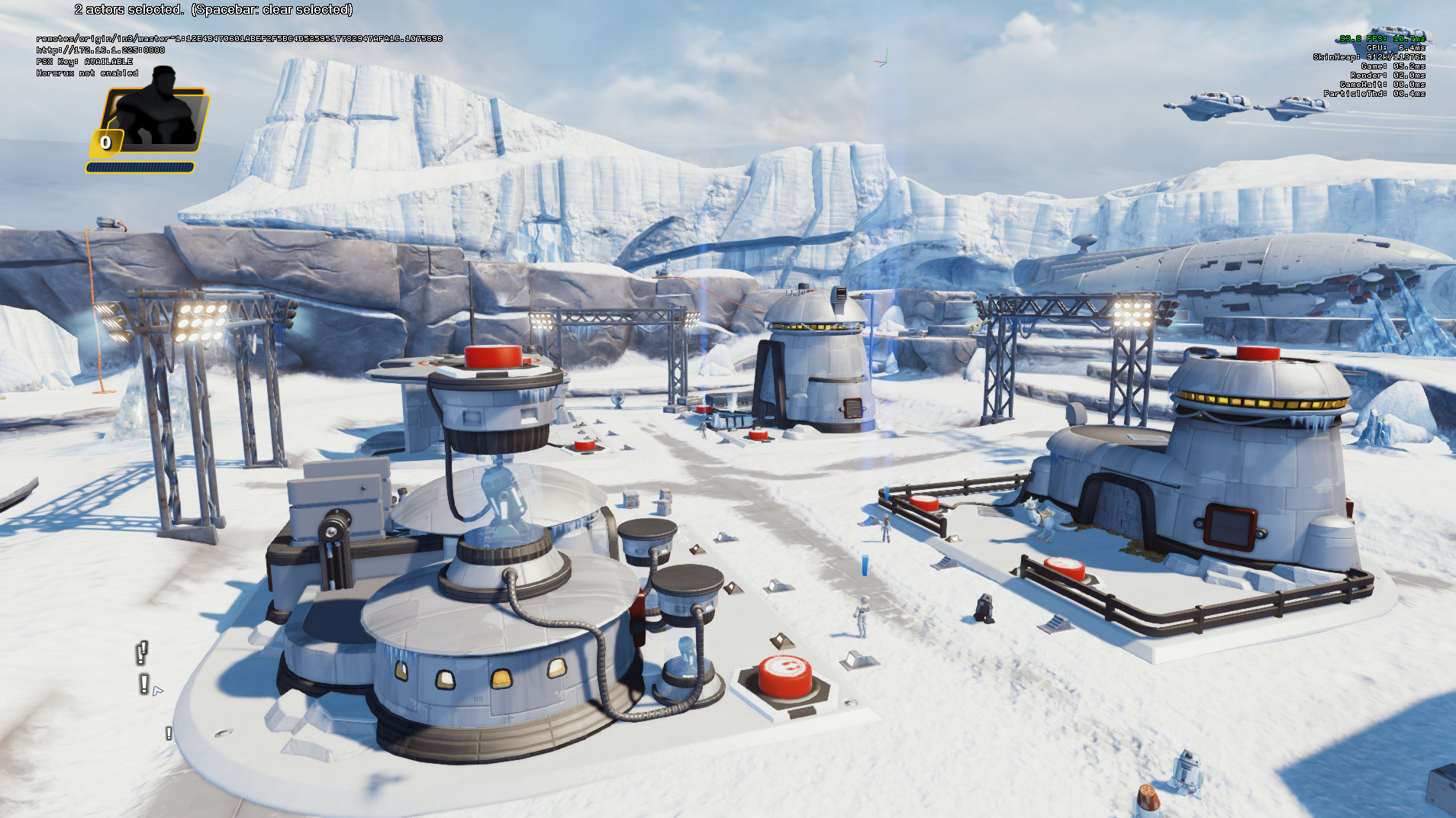
HOTH'S HANGAR
Another part of Hoth that I had full ownership of was Hoth’s Hangar.
Again, this area started off quite large but as I iterated and refined the design to focus more on our core vision the scope was reduced. It was a real challenge to decide on the scale of the Hangar and what exactly we wanted to feature here. In the end, Option 4 on the right, won out. The Hangar received such focus as it served as an opportunity to both illustrate iconic moments that are well known from Star Wars Episode V, and also to use it as the main landing zone of Hoth – obviously!
Because we were also developing for old gen systems, we always needed to consider some performance restrictions while loading a full new level. Having that in mind, one of the requirements of this space was to design an area that could offer a lot of gameplay interactions that would distract the player while the rest of the level would be loading in the background. This turned out to be a positive restriction as we managed to create a very cool space with loads of things to do, such as different types of collectibles to find, pipe climb traversal on cables, ledge hangs on roof top lamps, lightsaber doors and Tech Terminals.
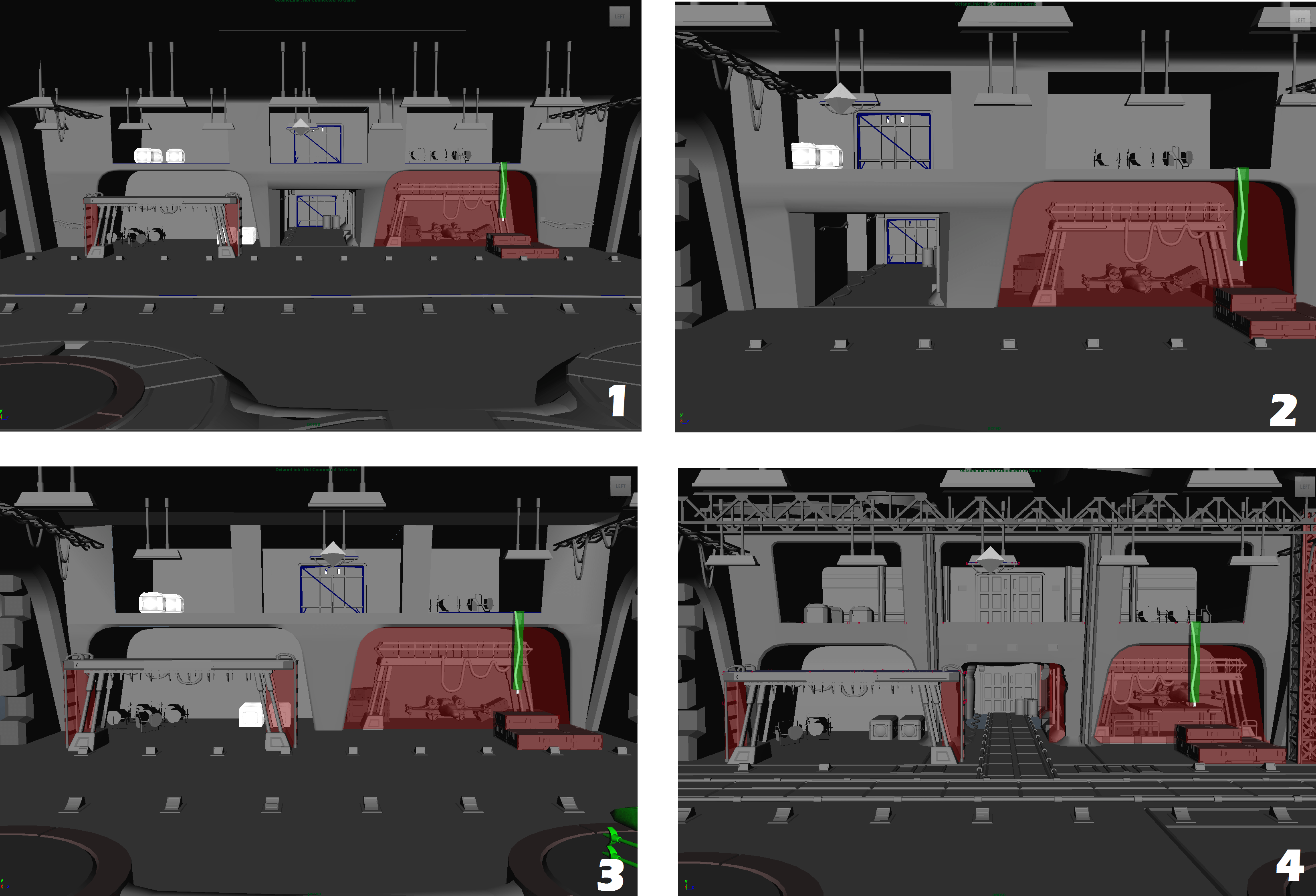
It was also intended to create a very busy space with Hoth's Hangar, with a lot of things going on at the same time. We wanted to create the same feeling that we all know from Hoth in the movie. One thing that I really didn’t want to leave out of this level was the iconic corridor from the scene where Han Solo and Leia have an argument, when the hero is about to leave the planet. I’m happy that we managed to keep it in the game as it also offered more areas to explore, and a subtle reward for die-hard fans.
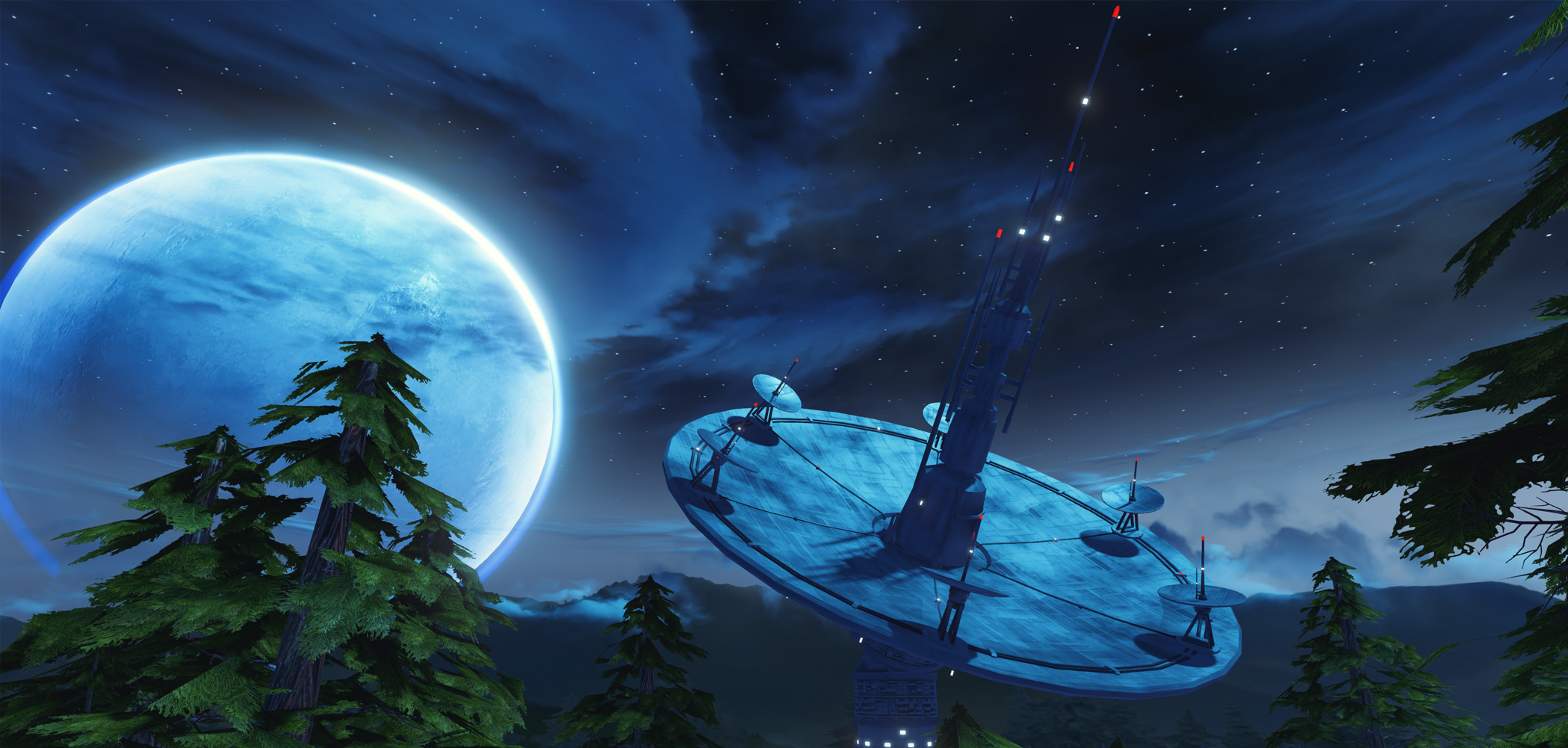
ENDOR - DESIGNING THE SURROUNDINGS
Towards the end of the development cycle, and with time running out, I was called in to assist the team working on Endor with some extra level design tasks and scripting open world missions. I supported mostly the design and level layout of the surroundings, such as a small part of the Ewok’s Village expansion, close to the Imperial Base.
Apart from that and the mapping of all Collectibles, hitching posts, checkpoints, Mynocks and Infinity’s Capsules, I also had full ownership of the Open World Missions and the Polishing tasks of some of the Main-Line Missions in this Planet.
As some of the missions I was scripting needed extra areas to support them, I worked on design additional areas for the village. Because of the tight schedule, I needed to iterate quickly before handing the greybox layouts over to the art team as there would be only a limited opportunity in which to apply further edits.
Between the Open World Missions that I designed, my favourite one is without doubt the “Catching the Fireflies” mission, in which the player would use the Ewoks as an ammo in a catapult, and shoot them towards the fireflies net. It is always a pleasure to see how much fun the kids were having during the playtest sessions and the final game.

OPEN-WORLD MISSIONS
In Rise Against the Empire Play Set, I had the complete ownership of all the Open World Missions in Tatooine, Hoth and Endor. This was a challenge to me, as we – as a team – was still learning how this type of missions worked and what were the rules we would need to be aware of to be able to fit with the whole Disney Infinity franchise – including how to visually communicate these and setting up the logic in the backend.
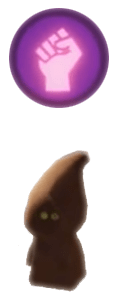
Open World Missions were a new type of missions introduced in Disney Infinity 3.0 that came as a response to bring back the original Infinity charm. By deemphasizing combat here, and setting up ourselves well by featuring Mission Givers that do not come equipped with certain licensing restrictions, we could accomplish the mission variety we desperately needed.
These missions are taken from traffic-type blockheads/NPCs. This involves a specific NPC giving specific types of tasks (i.e.: Princess Kneesa in Endor asking the player to use the Ewok’s catapults to bring the fireflies down). The main purpose of the open world missions is to allow players a predictable and reliable method of taking certain type of missions whenever they would like.
Open world missions had proven to be a success and well received by the players, as it added cool varieties, funny moments and not focusing too much on the traditional more serious quests.
MAIN-LINE FETCH, COLLECT & VEHICLE BASED MISSIONS
Apart from the complete ownership of the Open World Missions in the game, I was also responsible for Polishing a set of Main-Line Missions that were initially blocked out by our other designer in the team.
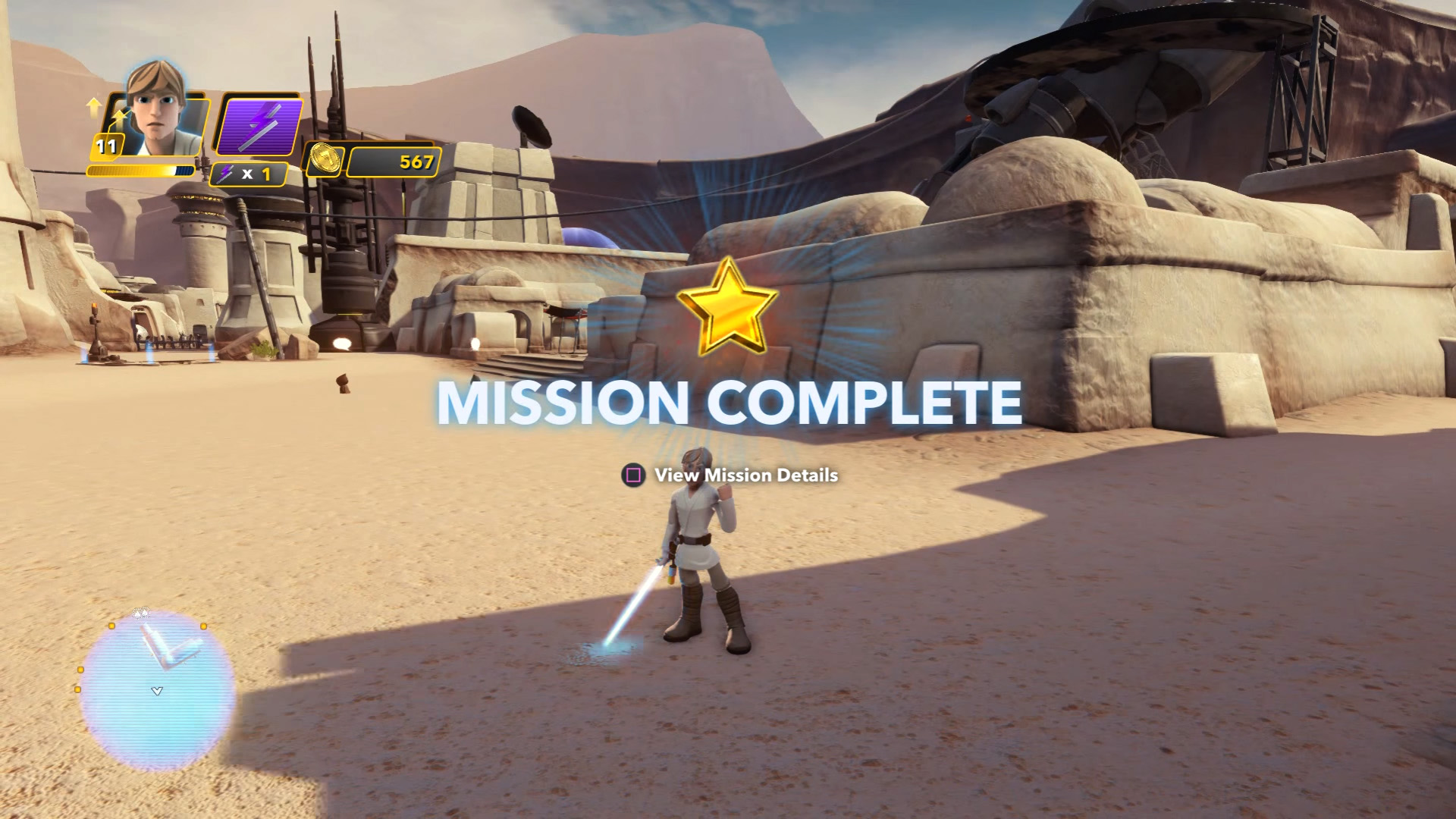
Story Missions (or Main-Line Missions) are exclusively narrative-driven missions that should always push the story of the play set forward. These missions are represented by a yellow “!” mark over the mission giver’s head.
The categories of Main-Line Missions assigned to me were from the group of Fetch, Collect and Vehicle Related Missions. Some mission examples are: Missing Band Members, Speeder Timed Collect, Baby Banthas, Rescue Soldier from Wampa, in a total of 19 Main-Line Missions.
I was responsible for the authoring of the final graphs logic, keeping it tidy and working around the best mapping for mission’s tasks, based on the results coming from our in-house playtest sessions.
OTHER PORTFOLIO PIECES
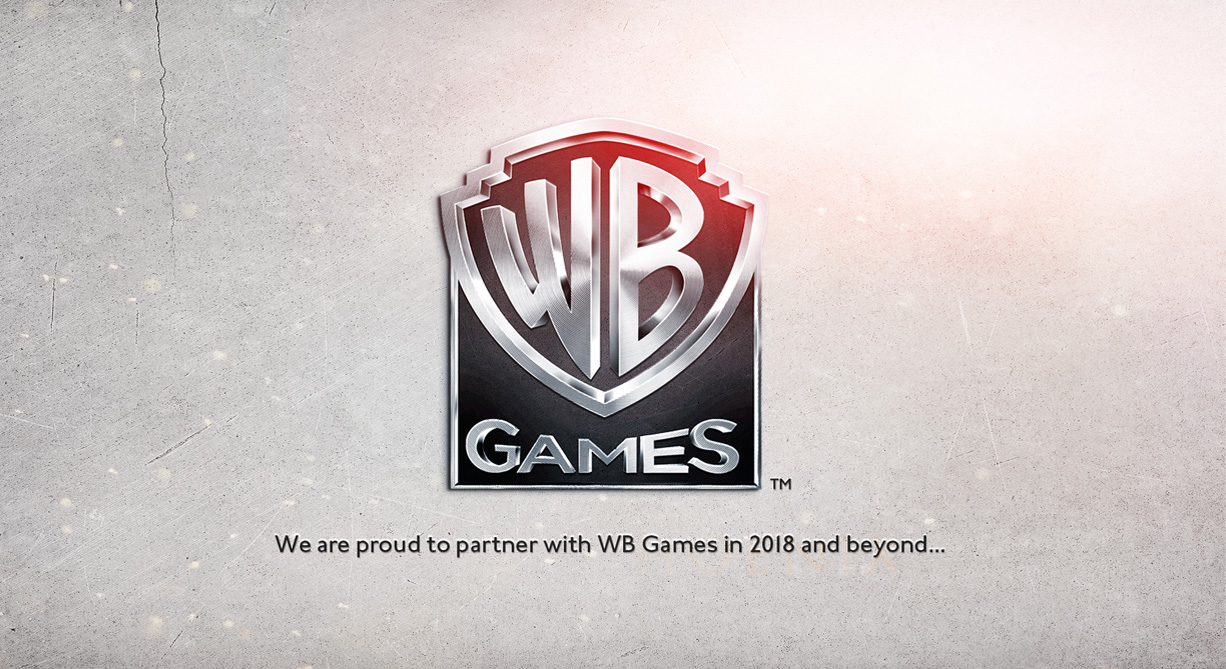
Hogwarts LegacyLead Designer
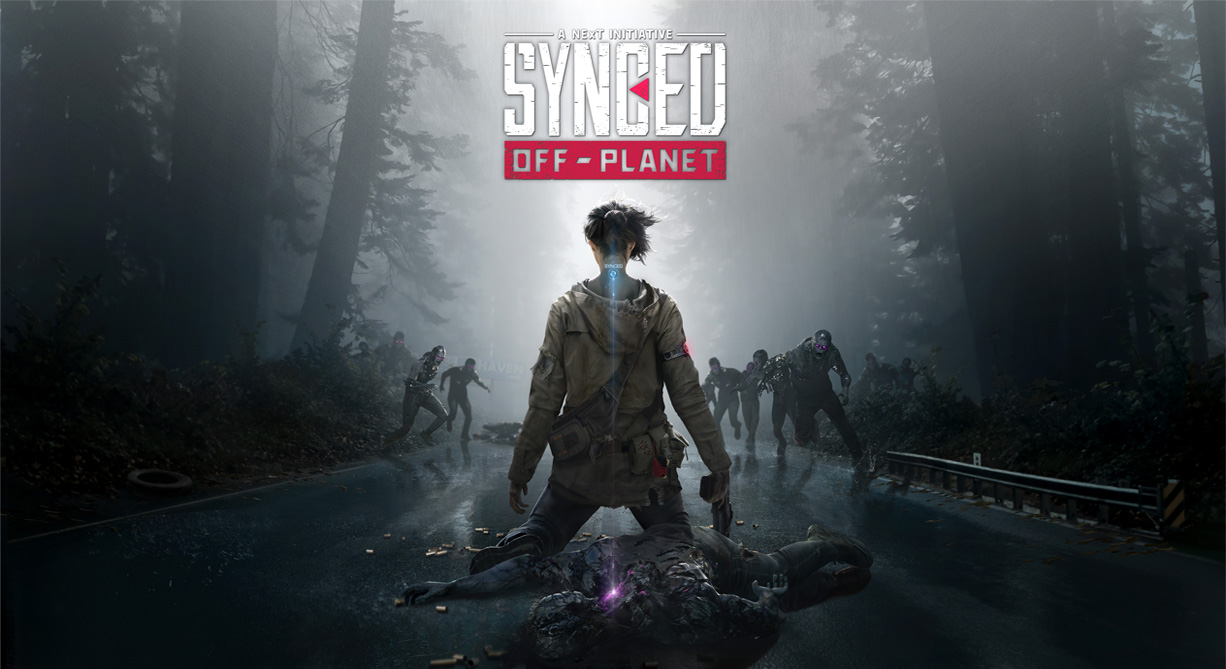
Synced: OFF-PlanetLead Designer
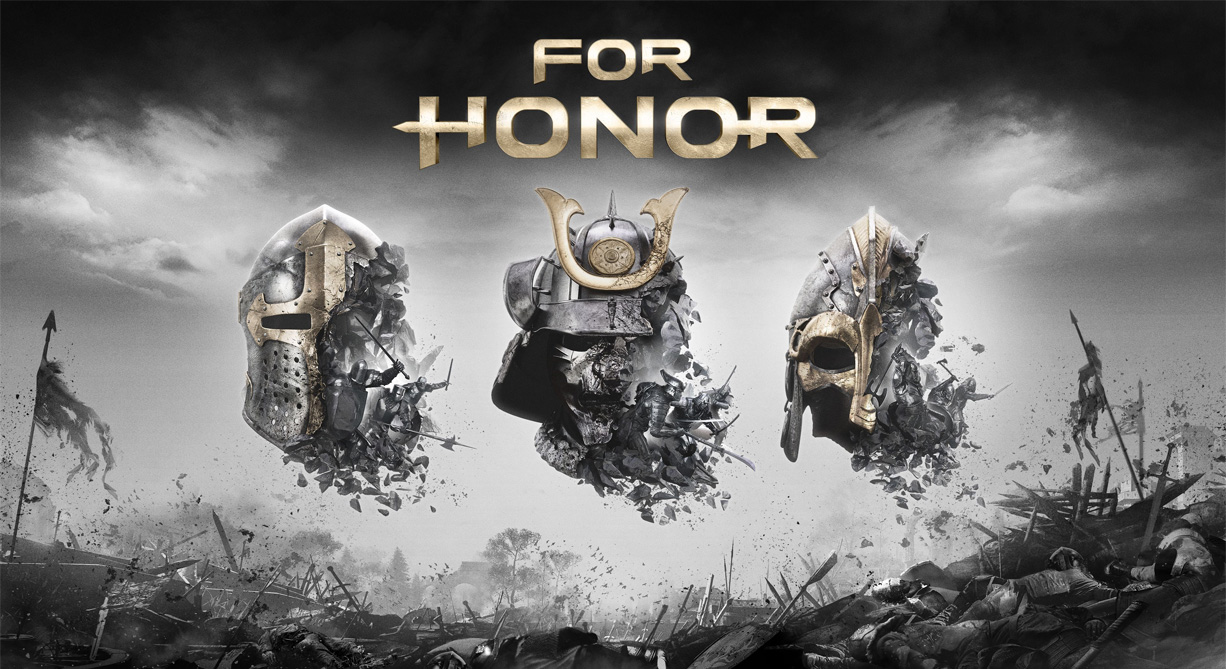
For HonorLead Designer
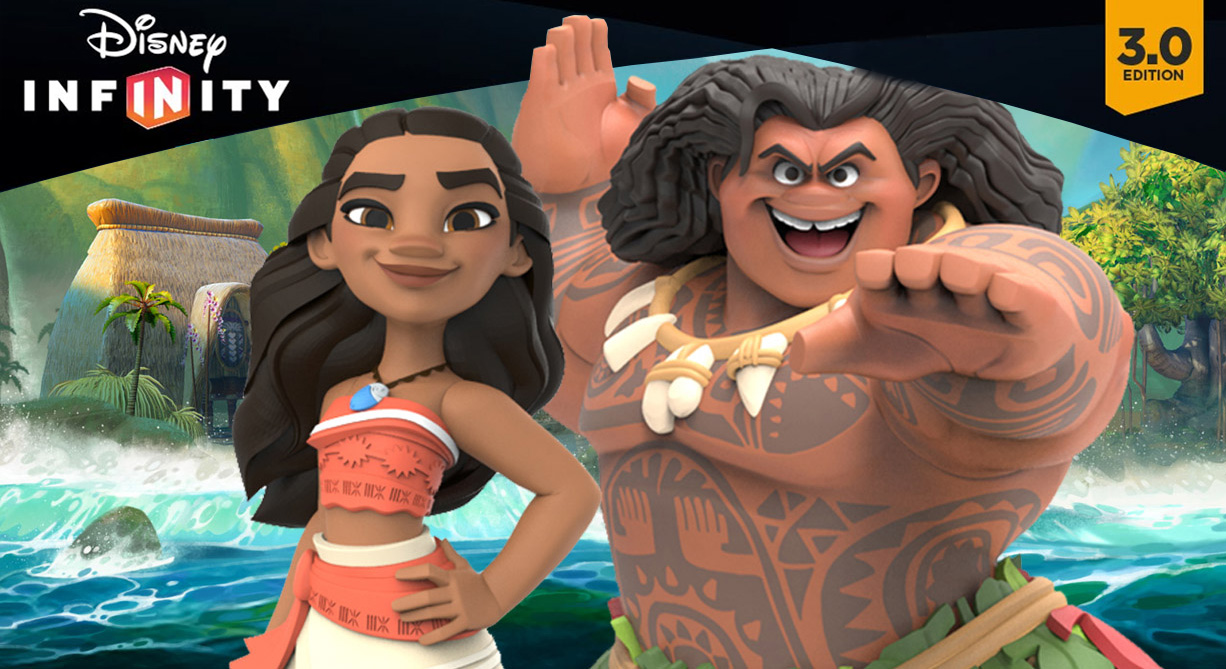
Disney Infinity: MoanaSenior Designer
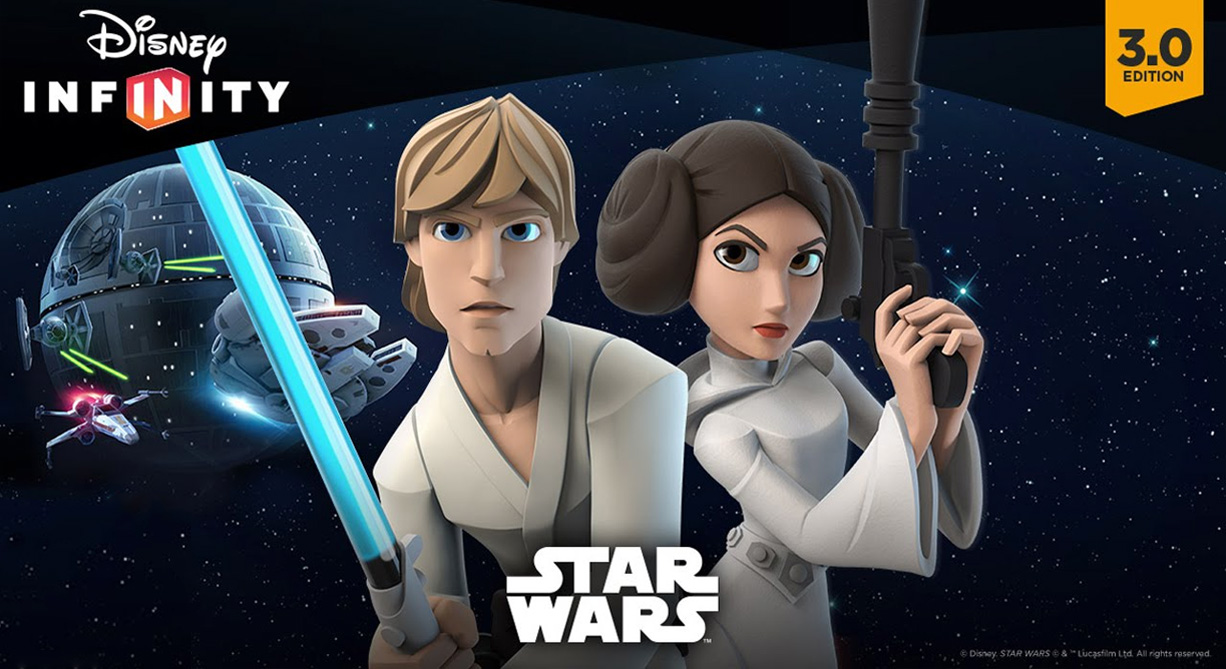
Disney Infinity: Star Wars Rise Against the EmpireGame & Level Designer
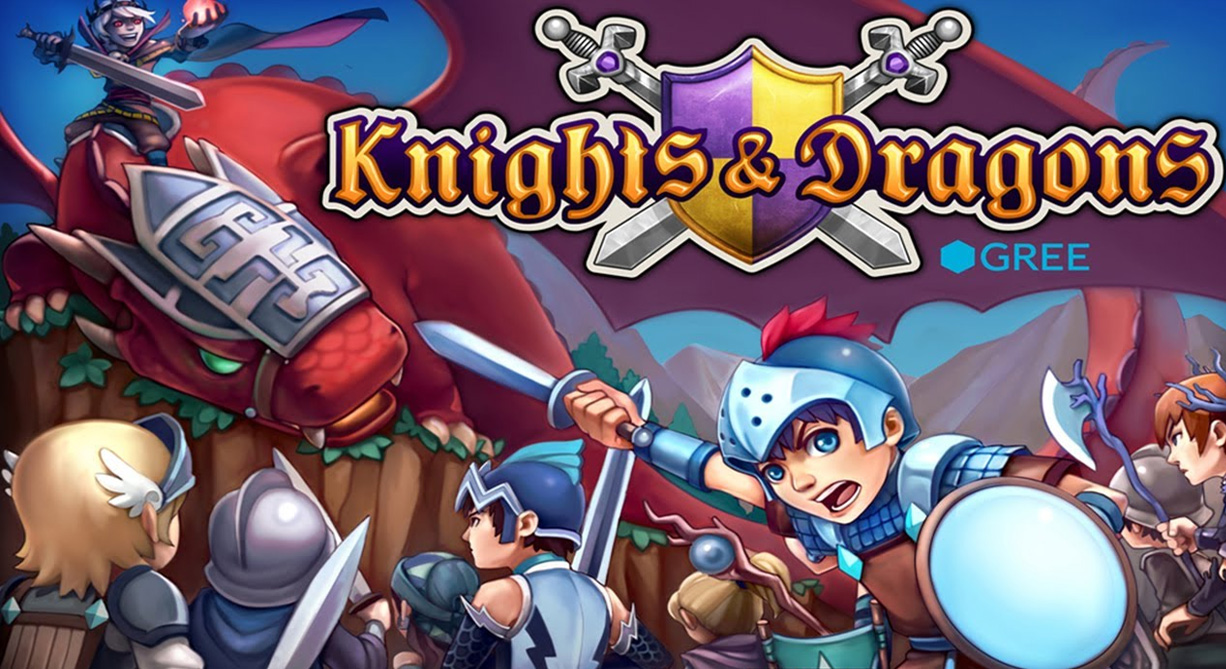
Knights and DragonsGame Designer & Live Ops




